Business population estimates for the UK and regions 2022: statistical release (HTML)
Published 6 October 2022
Headline statistics
The number of private sector businesses in the UK at the start of 2022 was
5.5 million
5.47 million businesses were small (0 to 49 employees)
35,900 businesses were medium-sized (50 to 249 employees)
7,700 businesses were large (250 or more employees)
Compared with 2021, the private sector business population has decreased by
1.5% (82,000 businesses)
Figure 1: Number of private sector businesses in the UK, 2000 to 2022

Numbers of UK businesses increased from 3.5 million in 2000 to 6.0 million in 2020, but have decreased to 5.5 million in 2021
What you need to know about these statistics
This publication provides the only official estimate of the total number of private sector businesses in the United Kingdom (UK) at the start of each year.
These estimates, produced by the Department for Business, Energy and Industrial Strategy (BEIS), cover a wider range of businesses than Office for National Statistics (ONS) outputs, which report on value-added tax (VAT) traders and pay as you earn (PAYE) employers. See related statistics section for links to ONS publications and Guide to business statistics explaining how each publication differs.
Introduction
This publication provides information on private sector businesses in the UK at the start of 2022, broken down by number of employees, legal status, industry, and geography. Employment and turnover data are also provided, primarily for use in classifying businesses by employee size band and to calculate shares of employment and turnover across industrial sectors, regions, and legal statuses. Counts of businesses (and associated employment and turnover) are based on businesses’ head office location. A business operating in a particular region/country with a head office located elsewhere is not included in the business count for the English region/country in question.
The publication:
-
reports on businesses in the private sector
-
excludes the government and not-for-profit sectors; an overview of the number of businesses in the whole economy is provided in Table 2 of the detailed tables
-
measures the net change in the number of private sector businesses, but cannot be used to estimate numbers of business start-ups or closures
-
estimates numbers of private sector businesses by combining estimated numbers of unregistered businesses with data on registered businesses derived from a comprehensive business register (the ONS Inter Departmental Business Register)
-
comprises this statistical release, a set of detailed tables, a methodology note and data underlying published charts and tables
-
quantifies uncertainty around key estimates of business numbers
Composition of the 2022 business population
The UK private sector comprises largely of non-employing businesses and small employers, as shown in Table A. SMEs (small and medium-sized enterprises) account for 99.9% of the business population. At the start of 2022:
-
there were estimated to be 5.5 million UK private sector businesses
-
1.4 million of these had employees and 4.1 million had no employees
-
therefore, 74% of businesses did not employ anyone aside from the owner(s)
-
there were 5.47 million small businesses (with 0 to 49 employees), 99.2% of the total business population
-
there were 35,900 medium-sized businesses (with 50 to 249 employees), 0.7% of the total business population
-
a further 7,700 businesses were large businesses (with 250 or more employees), 0.1% of the total business population
Table A: Estimated number of businesses in the UK private sector and their associated employment and turnover, by size of business, start of 2022
| Business | Employment (thousands) | Turnover (millions) | |
|---|---|---|---|
| All businesses | 5,508,935 | 27,054 | 4,156,773 |
| SMEs (0-249 employees) | 5,501,260 | 16,432 | 2,124,439 |
| Small businesses (0-49 employees) | 5,465,320 | 12,935 | 1,416,907 |
| With no employees | 4,061,035 | 4,399 | 277,599 |
| All employers | 1,477,900 | 22,655 | 3,879,174 |
| of which: | |||
| 1 to 9 employees | 1,187,045 | 4,308 | 530,456 |
| 10 to 49 employees | 217,240 | 4,228 | 608,852 |
| 50 to 249 employees | 35,940 | 3,497 | 707,532 |
| 250 or more employees | 7,675 | 10,622 | 2,032,334 |
Notes for table A:
- turnover column: figures exclude Section K (financial and insurance activities) where turnover is not available on a comparable basis
- “with no employees” category comprises sole proprietorships and partnerships with only a self-employed owner-manager(s) and companies with one employee, assumed to be a working proprietor
The 7,700 large businesses in the UK make a major contribution to employment and turnover. Nonetheless, SMEs account for three-fifths of the employment and around half of turnover in the UK private sector. At the start of 2022:
-
total employment in SMEs was 16.4 million (61% of the total), whilst turnover was estimated at £2.1 trillion (51%)
-
employment in small businesses was 12.9 million (48%) and turnover £1.4 trillion (34%)
-
employment in medium-sized businesses was 3.5 million (13%) and turnover £0.7 trillion (17%)
-
employment in large businesses was 10.6 million (39%) and turnover £2.0 trillion (49%)
-
further information on composition is shown in Table 1 in the detailed tables that accompany this publication, and in Figure 2
Figure 2: Contribution of different sized businesses to total population, employment and turnover, start of 2022
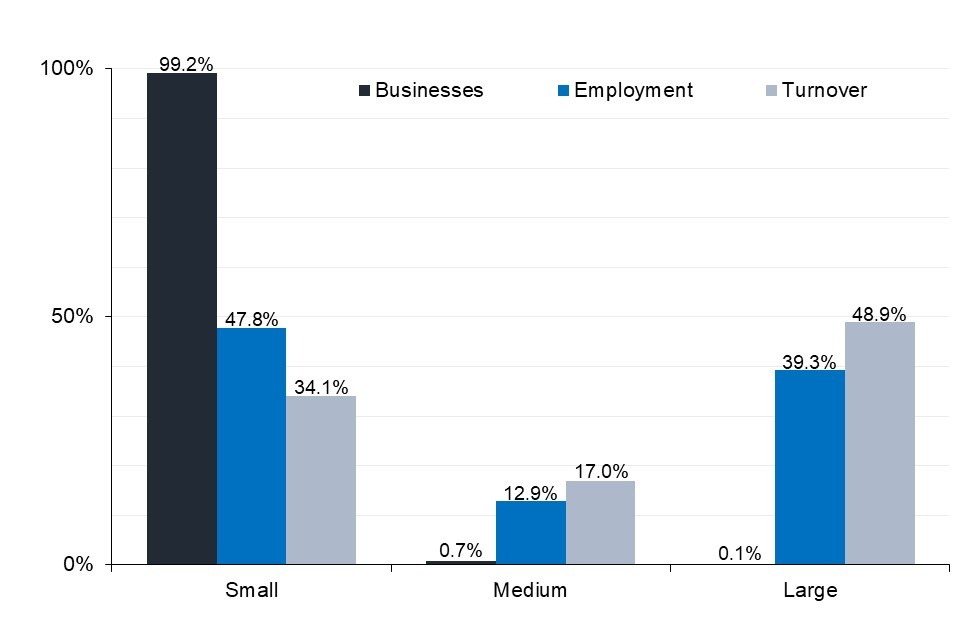
Small businesses account for over 99.9% of businesses, whilst accounting for nearly half of employment and over a third of turnover
Note for figure 2
- turnover figures exclude Standard Industrial Classification (SIC) 2007 Section K (financial and insurance activities) where turnover is not available on a comparable basis
Legal form
There are three main legal forms of businesses in the private sector; sole proprietorships, ordinary partnerships, and companies. Sole proprietorships are the most common legal form. At the start of 2022:
-
the UK private sector business population comprised 3.1 million sole proprietorships (56% of the total), 2.1 million actively trading companies (37%) and 353,000 ordinary partnerships (6%)
-
1.1 million companies were employers, as were 220,000 sole proprietorships and 95,000 ordinary partnerships
-
2.9 million sole proprietorships, 932,000 companies and 257,000 ordinary partnerships did not employ anyone aside from the owner(s)
-
further information on legal form is given in Figure 3 and Table C, and Table 3 of the detailed tables
Figure 3: Number of businesses in the UK private sector with and without employees, by legal status, start of 2022
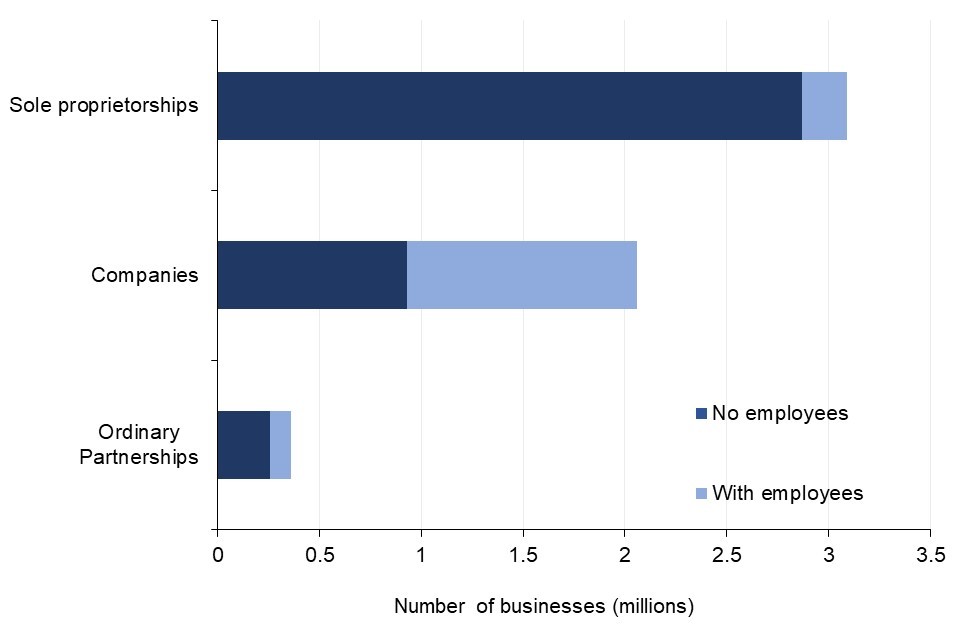
The majority of businesses with 0 employees are sole proprietorships and most businesses with employees are companies
Registration for VAT and PAYE
Just over three quarters of UK private sector businesses are non-employers, and the majority of these are not registered for either VAT (value added tax) or PAYE (pay as you earn). At the start of 2022:
-
the Office for National Statistics recorded 2.7 million private sector businesses as registered for VAT or PAYE, 49% of the estimated total population
-
2.8 million businesses (51%) traded without being registered for VAT or PAYE and are classified here as ‘unregistered’
-
14% of sole proprietorships and 52% of ordinary partnerships were registered for VAT or PAYE
Trends in the business population
Between 2000 and 2022:
-
the business population increased by 2.0 million (59%)
-
the highest rate of increase was 6.8% between 2013 and 2014, followed by 6.7% between 2003 and 2004
-
in contrast, the decrease of 1.5% between 2021 and 2022 is only the third decrease in the series, all of which have occurred since 2017. The largest decrease was 6.5% between 2020 and 2021
Between 2021 and 2022:
-
the total business population decreased by 82,000 (1.5%)
-
there were 32,000 more (2.3%) employing businesses and 114,000 fewer (2.7%) non-employing businesses
-
The decrease in non-employing businesses resulted from a decrease of 98,000 (3.3%) unregistered businesses, and a decrease in non-employing registered businesses of 16,000 (1.3%)
-
the net change in the business population is determined by the balance of new business start-ups and de-mergers (inflows) against those businesses that closed, merged or were taken over by another business (outflows)
-
further information on trends is in Tables B and C, Figures 4, 5 and 6, and Tables 25 to 28 of the detailed tables
Table B: Estimated number of businesses (in thousands) in the UK private sector by employment size-band, start of 2000, and 2018 to 2022
| 2000 | 2018 | 2019 | 2020 | 2021 | 2022 | |
|---|---|---|---|---|---|---|
| All private sector | 3,467 | 5,668 | 5,868 | 5,981 | 5,591 | 5,509 |
| All SME (0-249) | 3,460 | 5,660 | 5,860 | 5,973 | 5,583 | 5,501 |
| All small (0-49) | 3,433 | 5,625 | 5,825 | 5,937 | 5,548 | 5,465 |
| All employers (1+) | 1,111 | 1,389 | 1,410 | 1,413 | 1,416 | 1,448 |
| Non-employers | 2,356 | 4,278 | 4,458 | 4,568 | 4,175 | 4,061 |
| Micro (1 to 9) | 914 | 1,137 | 1,155 | 1,157 | 1,162 | 1,187 |
| Small (10 to 49) | 163 | 210 | 211 | 212 | 211 | 217 |
| Medium (50 to 249) | 27 | 35 | 36 | 36 | 36 | 36 |
| Large (250+) | 7 | 8 | 8 | 8 | 8 | 8 |
Growth in the UK private sector business population since 2000 has mainly been due to increasing numbers of non-employing businesses, as shown in Figures 4 and 5. Since 2000:
-
the number of non-employing businesses has increased by 1.7 million (72%)
-
the number of employing businesses has increased by 337,000 (30%)
-
non-employing businesses accounted for 84% of total growth over the period
Figure 4: Growth in the number of UK private sector businesses by size band, 2000 to 2022 (index: base year = 2000)
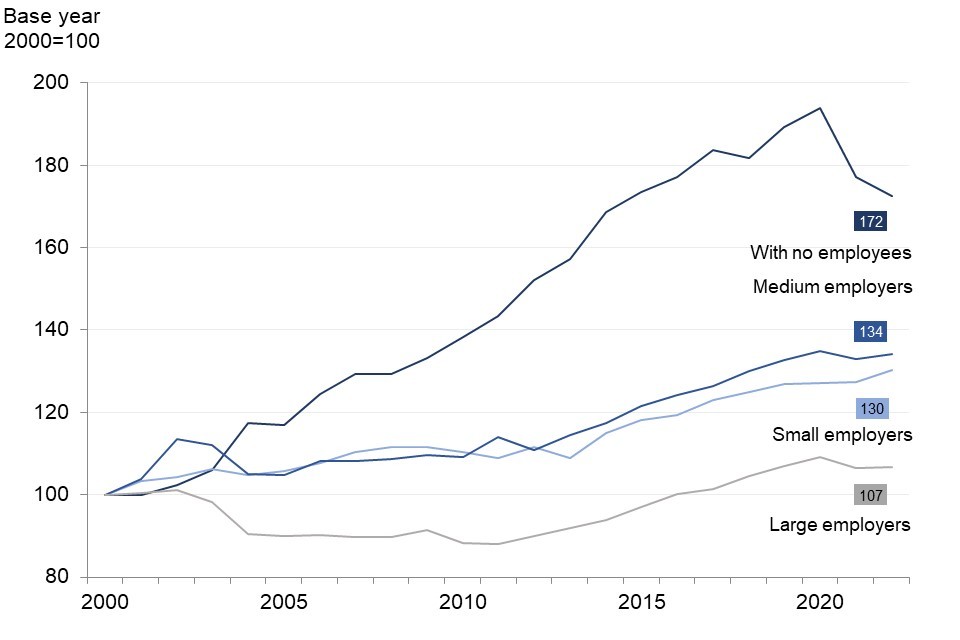
Between 2000 and 2022 increases in numbers of non-employing businesses has been far larger than the increase in numbers of employing businesses.
Figure 5: Non-employing and employing businesses in the UK private sector, 2000 and 2018 to 2022

Numbers of businesses increased since 2000 for both employing and non-employing businesses, before a decrease in non-employing businesses since 2020.
Overall the number of SMEs has increased by 2.0 million (59%) since 2000, including 336,000 SME employers (30%). Over this period:
-
the number of small employing businesses grew by 30%
-
the number of medium-sized employers grew by 34%
-
the number of large businesses grew by 7%
In the last year (as shown in Table C and figure 6), the number of companies increased by 16,000 (1%). Sole proprietorships decreased by 66,000 (2%). Ordinary partnerships decreased by 32,000 (8%).
Looking at the period between 2010 and 2022:
-
the number of sole proprietorships grew by 335,000 (12%) and the number of companies increased by 794,000 (63%)
-
in contrast, the number of ordinary partnerships fell by 103,000 (23%)
Table C: Changes in the number of businesses, by legal status, between the start of 2021 and the start of 2022
| Sole proprietorships | Ordinary Partnerships | Companies | Total | |
|---|---|---|---|---|
| Unregistered businesses | -69,400 | -28,100 | N/A | -97,500 |
| Registered businesses | 3,100 | -3,700 | 16,100 | 15,500 |
| Of which | ||||
| with employees | -100 | -2,900 | 35,000 | 31,900 |
| without employees | 3,300 | -800 | -18,800 | -16,400 |
| All private sector | -66,300 | -31,800 | 16,100 | -82,000 |
Notes for table C:
- numbers of businesses are rounded, in order to avoid disclosure. Consequently, totals may not exactly match the sum of their parts
- the unregistered business category comprises self-employed people working alone or in partnership
- N/A (not applicable) - BPE methodology assumes all companies are registered
- ‘registered’ businesses are those businesses registered for VAT and/or PAYE
Figure 6: Percentage change in the number of VAT/PAYE registered and unregistered businesses by legal form, between the start of 2021 and the start of 2022
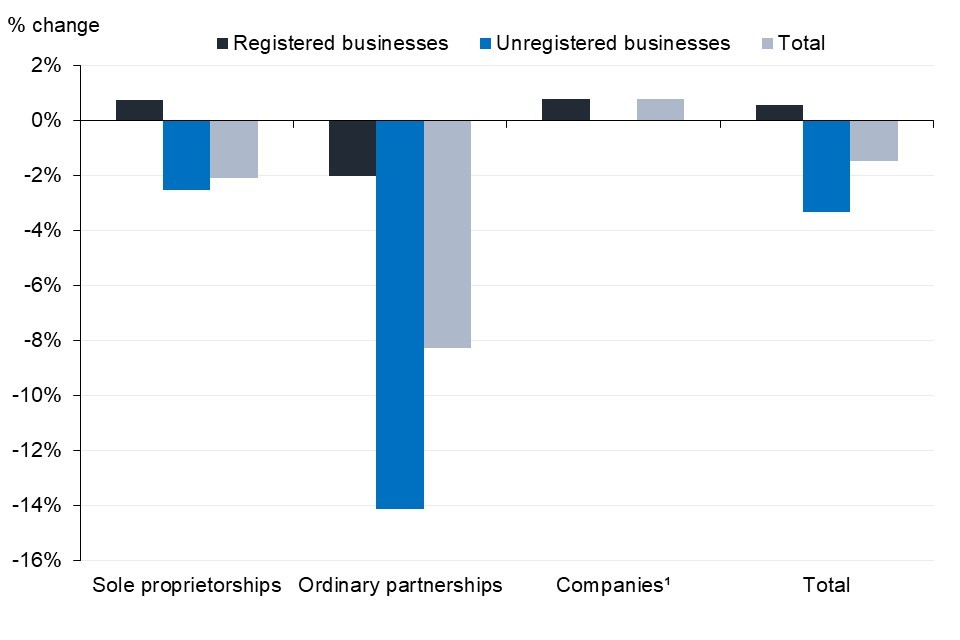
Unregistered business numbers have decreased for all legal forms in the last year, whilst registered business numbers have experienced a slight decrease in numbers of partnerships and slight increases in other legal forms.
Note for figure 6:
- the BPE methodology assumes all companies are registered: see paragraph 29 of the Methodology note
In terms of employment trends:
-
total employment across all private sector businesses increased from 27.0 million at the start of 2021 to 27.1 million at the start of 2022, a increase of 0.3%
-
the SME share of total employment was 61% in 2022
-
total employment in SMEs increased from 16.3 million at the start of 2021 to 16.4 million at the start of 2022, an increase of 0.6%
-
further information on employment trends is in Table 28 of the detailed tables
UK countries and the regions
Counts of businesses (and associated employment and turnover) are based on businesses’ head office location. A business operating in a particular region/country with a head office located elsewhere is not included in the business count for the region/country in question.
Private sector businesses are not evenly distributed across the UK. London and the South East of England have considerably more businesses than any other UK country or region of England, as shown in Figure 7. At the start of 2022:
-
there were 4.8 million private sector businesses in England, 341,000 in Scotland, 219,000 in Wales, and 128,000 in Northern Ireland
-
London (1.0 million) and the South East of England (844,000) had the most private sector businesses, accounting for 34% of the UK business population
-
the North East had the fewest private sector businesses amongst English the regions (155,000)
-
further information on location is in Table 9 of the detailed tables
Figure 7: Number of private sector businesses by English region and UK country, start of 2022
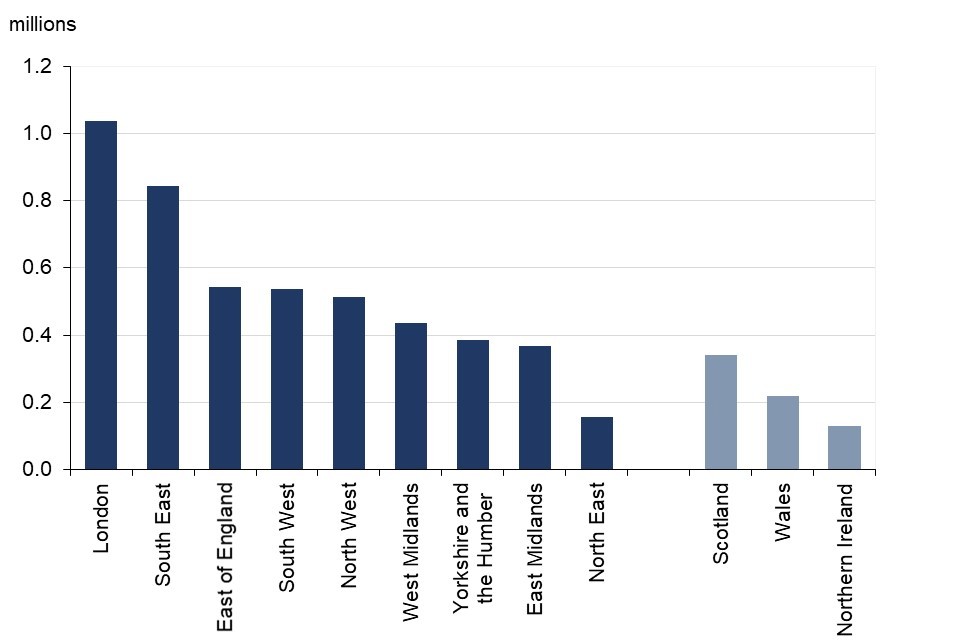
Business numbers are highest in London and South East, lowest in North East and Northern Ireland
For countries and English regions below UK level caution is required in assessment of changes over time due to the level of uncertainty in the estimates (see section “Uncertainty in the business population estimates”).
In the last year:
-
numbers of private sector businesses decreased by 86,000 in England and by 1,000 in Scotland, whilst numbers increased in both Wales (11,000) and Northern Ireland (4,000)
-
in percentage terms numbers of private sector businesses decreased by 2% in England and by less than 1% in Scotland, whilst increasing by 5% in Wales and by 4% in Northern Ireland
-
the number of private sector businesses declined in six of nine English regions
-
the South East was the English region with the largest numeric decrease (31,000), followed by Yorkshire and the Humber (28,000), whilst the largest percentage increase was in the South West (15,00%)
-
in percentage terms, the English regions with the largest decreases were Yorkshire and the Humber (7%) and the East of England (4%); the largest increase was in the South West (3%)
-
changes were driven largely by reductions in numbers of unregistered businesses which are estimated using survey data and therefore subject to uncertainty
-
further information on regional trends is in Table 26 of the detailed tables
Since 2010:
-
the number of businesses has increased in all the UK countries and regions
-
the largest increase, in percentage terms, was in London (44%)
-
the smallest percentage increase was in Northern Ireland (7%).
-
further information on regional trends is in Table 26 of the detailed tables
Along with London, the South West, the South East and the East of England the highest business density rates in the UK, based on the size of the resident adult population, as shown in Figure 8. At the start of 2022:
-
London (1,452) had the highest number of businesses per 10,000 adults. There were also relatively high rates in the South West (1,152), South East (1,134) and the East of England (1,075)
-
the North East of England had the lowest business density rate (704) of any English region or UK country
-
Northern Ireland (855), Wales (839) and Scotland (752) had relatively low business density rates compared to the UK average (1,014)
-
further information on business density is in Table 8 in the detailed tables
Figure 8: Number of businesses in the UK private sector per 10,000 adults, UK region and country, start of 2022
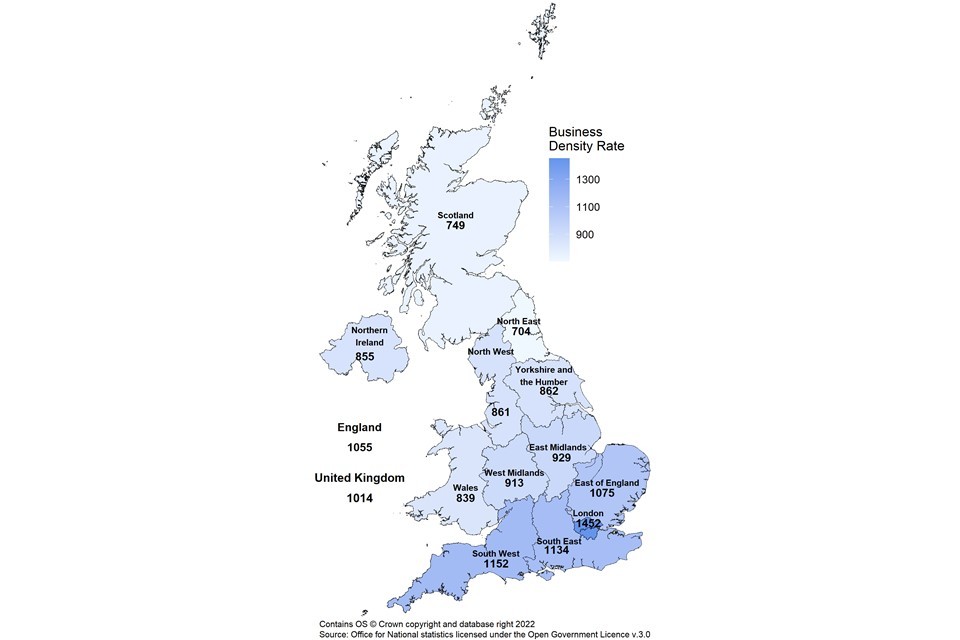
Business density is highest in London, the South West and South East, lowest in North East and Scotland
Industries
SMEs account for at least 99% of the overall population in each of the main industry sectors and therefore determine the distribution of the business population overall. At the start of 2022:
-
the largest number of SMEs (914,000 or 17%) were operating in Construction, as shown in Figure 9, compared with less than 1% in the Mining, Quarrying and Utilities sector (32,000)
-
there were also a considerable number of SMEs operating in the Professional, Scientific and Technical Activities (762,000 or 14%), and Wholesale and Retail Trade and Repair sectors (547,000 or 10%)
Figure 9: Industrial sectors with most SMEs, as percentage of total SME numbers, start of 2022

SMEs are most numerous in the construction sector
SMEs accounted for 61% of employment and 51% of turnover at the start of 2022. Wholesale and Retail Trade is the industrial sector which has the highest share of both SME employment and turnover, see Figure 10. At the start of 2022:
-
Wholesale and Retail Trade and Repair accounted for 14% of all SME employment and 34% of SME turnover in the UK private sector
-
almost a third of SME turnover was spread across three more sectors: Construction (12%), Professional, Scientific and Technical (11%) and Manufacturing (9%)
-
further information for industries is in Table 5 in the detailed tables
Figure 10: Industrial sectors with highest SME turnover and employment, as percentage of total SME employment and turnover, start of 2022

SME turnover is highest in the Wholesale and retail trade; repair of motor vehicles and motorcycles sector
Note for figure 10
- turnover figures exclude SIC 2007 Section K (Financial and Insurance Activities) where turnover is not available on a comparable basis
Large businesses accounted for 39% of employment and 49% of turnover. At the start of 2022:
-
the sector with the most large businesses was Manufacturing (1,200), followed by Wholesale and Retail (1,100), and Administrative and Support Service Activities (1,100)
-
Wholesale and Retail Trade and Repair accounted for 25% of all large business employment and 35% of large business turnover in the UK private sector
-
the second largest sector in terms of large business employment was Administrative and Support Service Activities, which accounted for 14% of the total
-
the second largest sector in terms of large business turnover was Manufacturing, which accounted for 19% of the total
A time series by industrial sector has been published for the first time in this year’s edition (Table 29 in the detailed tables). For estimates by industrial sector, caution is required in assessment of changes over time due to the levels of uncertainty. The publication includes a section quantifying uncertainty around estimates of business numbers by industrial sector (see section “Uncertainty in the business population estimates”).
In the last year:
-
the greatest numeric increase in businesses was in Transportation and Storge (28,000). The percentage increase was greatest in the Accommodation and Food Service Activities (10%)
-
the greatest numeric decreases in businesses were in Professional, Scientific and Technical Activities (86,000) and Manufacturing (26,000). The percentage decrease in both of these sectors was 10%. The percentage decrease was greatest in Financial and Insurance Activities (15%)
-
changes were driven largely by reductions in numbers of unregistered businesses which are estimated using survey data and therefore subject to uncertainty.
-
the registered business population (which is not subject to the same uncertainty) increased by 16,000 (0.6%). Amongst registered businesses, the sectors Construction, and Wholesale and Retail Trade; Repair of Motor Vehicles and Motorcycles had the largest numerical increases (17,000 and 13,000 respectively). The percentage increase was greatest in Accommodation and Food Service Activities (5%). The sectors Professional, Scientific and Technical Activities, and Information and Communication had the largest numeric decreases (20,000 and 16,000 respectively). The percentage decrease was greatest in the Information and Communication sector (8%)
Since 2010:
-
the business population increased in all industrial sectors
-
Administrative and Support Service Activities had the largest numeric increase (165,000). The greatest percentage increase was in Real Estate Activities (66%)
-
Agriculture, Forestry and Fishing had the smallest numeric increase (2,000)
-
Construction, consistently the sector with the largest number of businesses (914,000 in 2022), has had the smallest percentage increase (2%), along with Agriculture, Forestry and Fishing (2%)
Uncertainty in the business population estimates
Numbers of unregistered businesses reported in this publication are estimated, based on Labour Force Survey data. This leads to uncertainty in the total count of businesses in the private sector, which comprises the sum of unregistered business numbers and registered business numbers. Registered businesses are not estimated, being derived from an administrative data source, the Inter-Departmental Business Register (IDBR). IDBR data does contain other sources of error, which are likely to be small for counts of businesses. These are difficult to quantify and not captured in the measurements of uncertainty used in this publication, 95% confidence intervals (CIs) and coefficients of variation (CVs).
CIs indicate a range of values around an estimate within which the ‘true’ value of the estimate is likely to lie, with 95% probability. CIs are the same for both estimates of unregistered business numbers and estimates of all private sector businesses numbers.
CVs, the ratio of an estimate’s standard error to the estimate itself expressed as a percentage, indicate the quality of estimates. The smaller the CV, the more precise the estimate. Values less than 5% indicate an estimate is precise for most practical purposes, those over 20% indicate an estimate is unreliable. CVs differ for estimates of unregistered business numbers and estimates of all private sector businesses numbers, being smaller for the combined total than for the unregistered component.
At the start of 2022, the 95% CI around the total number of private sector businesses, estimated at 5,509,000, was ±107,000. On this basis, at the start of 2022:
-
there was a 95% probability that the total number of businesses in the private sector was between 5,402,000 and 5,616,000
-
the CV was 1%, indicating the estimate was precise
Figure 11: Estimated private sector businesses numbers in each English region, Scotland, Wales and Northern Ireland, with 95% CIs, start of 2022
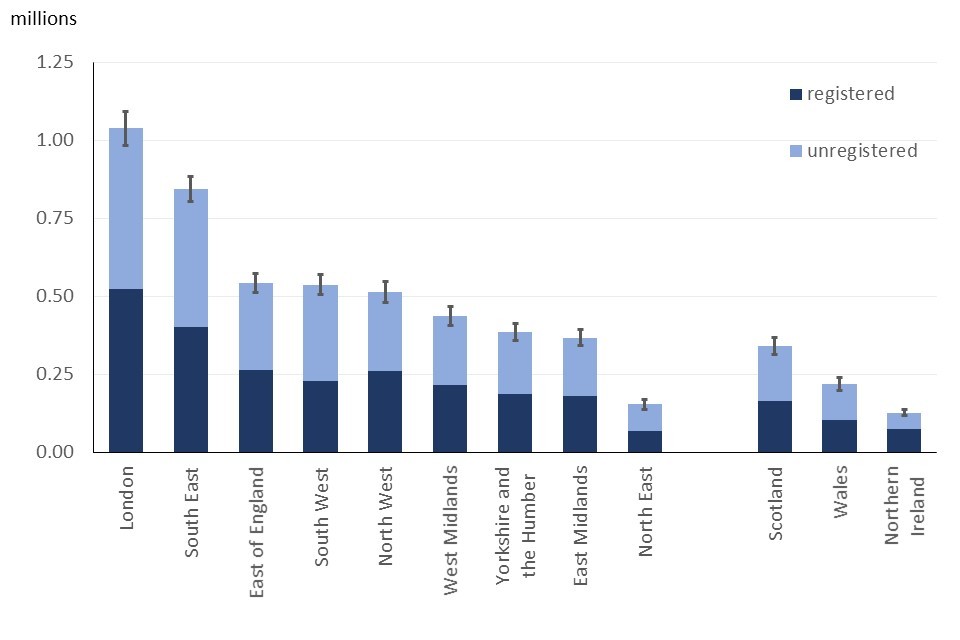
Country/English region business counts with 95% CIs, which are largest for London and smallest for Northern Ireland
For data shown in Figure 11:
- the smallest CV for the countries and English regions shown in Figure 11 was 2% for the South East, indicating the estimate was precise
- the North East and Wales had the largest CVs (5%) though estimate quality was still good.
For private sector businesses numbers in England (not shown in Figure 11), estimated at 4,821,000, the 95% CI was ±101,000 and the CV was 1%.
Figure 12: Estimated private sector businesses numbers by industrial sector, with 95% CIs, start of 2022
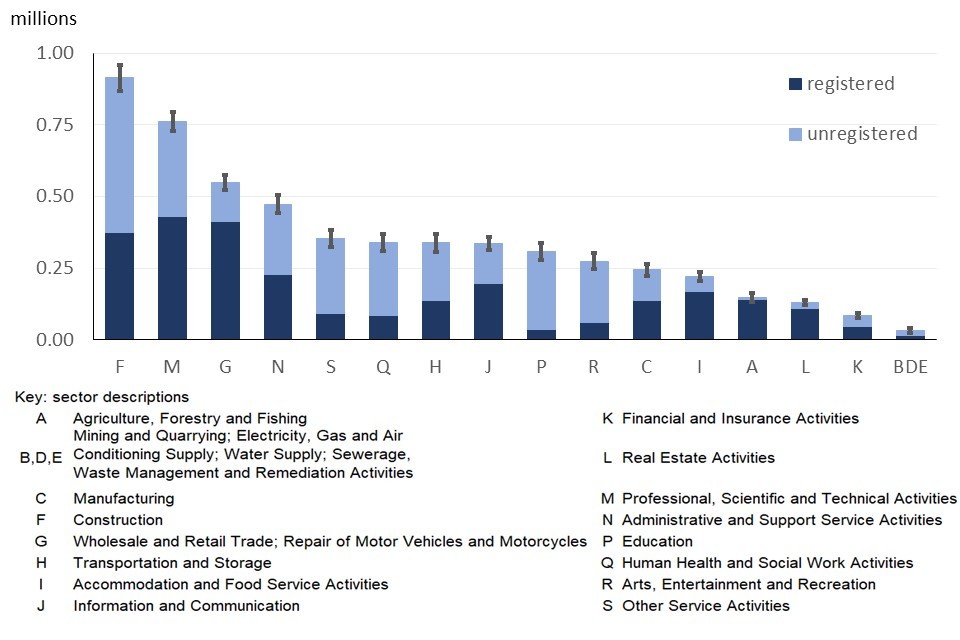
Business counts with 95% CIs for sectors. CIs are largest for Sector F (Construction) and smallest for the combined BDE sector
For data shown in Figure 12:
- CVs for Sectors G (Wholesale and Retail Trade; Repair of Motor Vehicles and Motorcycles) and M (Professional, Scientific and Technical Activities) were smallest (both 2%) indicating estimates were precise
- the combined sector B, D and E (Mining and Quarrying; Electricity, Gas and Air Conditioning Supply; Water Supply: Sewerage, Waste Management and Remediation Activities) had the largest CV (12%), indicating the estimate was acceptable.
Table 30 in the detailed tables provides further details of CIs and CVs for all business numbers and unregistered business numbers at the country and English region level, by industry sector, and at the more detailed level of industry sector by country and English region.
The processes used to quantify uncertainty in this publication is described in the section “Accuracy” in the Methodology and Quality Note.
Technical information
- This publication is the latest in a series providing estimates of the total number of private sector businesses in the UK. It estimates the total number of UK private sector businesses at the start of each calendar year, including those that are registered for VAT or PAYE and those that are unregistered. Related ONS publications report only on VAT/PAYE registered businesses.
- A Guide explaining how this publication relates to other National Statistics on business population and demography has been published to help users understand the differences and choose the most appropriate source.
- There is no single database containing all private sector businesses in the UK. The main source for this publication is the Inter-Departmental Business Register (IDBR), managed by the Office for National Statistics (ONS), which is used to provide data on VAT/PAYE registered businesses in the UK. This publication also includes estimates of smaller non-employing (unregistered) businesses which are calculated using a combination of information from the ONS Labour Force Survey and HMRC self-assessment tax return data. More detail on the estimation process is provided in the Methodology and Quality Note
- Companies can take a range of legal forms, including Public Limited Companies, Private Limited Companies, Limited Liability Partnerships, and others. The IDBR only counts actively trading companies, rather than all those recorded on the Companies House register.
- This edition uses the same methodology as that used since the 2011 edition of this publication. The methodology differs from that used for BPE 2010 and the older SME Statistics series (1994-2009).
- To enable robust comparison over time, a time series is calculated using the latest methodology and data. This shows annual estimates of numbers of private sector businesses in the UK between 2000 and 2022. Estimates for UK countries/English regions and for different legal forms have been provided for years since 2010 (the first year for which consistent estimates can be produced).
- Information on business employment and turnover is also provided. The function of this data is primarily to (i) classify businesses by employee size band and (ii) calculate shares of employment and turnover across industrial sectors, regions, and legal statuses. This release includes an employment time-series in Table 28 of the detailed tables. However, users should note that these employment estimates are indicative: ONS publishes other sources of employment data more suitable for monitoring total jobs and people in employment. See the Workforce Jobs series, the Business Registers Employment Survey (BRES), and the wider Labour Market Statistics (refer to the Methodology and Quality Note for more information). Likewise, for registered businesses the recommended source of turnover data is the Annual Business Survey
- IDBR employment data is updated from administrative sources (Her Majesty’s Revenue & Customs (HMRC) Pay As You Earn (PAYE) records and Office for National Statistics (ONS) Surveys. It is recommended that Business Register Employment Survey (BRES) estimates are used as the main source of employment information for detailed industry and geographical employment comparisons for registered businesses. The only time that IDBR employment should be considered for use is for very small area, below the level of BRES publication.
- IDBR turnover is updated via administrative sources (HMRC VAT records) and ONS Business Surveys. It is recommended that the Annual Business Survey (ABS) turnover estimates are used as the main source of turnover information for detailed industry and geographical turnover comparisons. The only time that IDBR turnover should be considered for use is for very small area, or fine cross tabulations, below the level of ABS publication.
- Turnover data throughout this release excludes SIC2007 Section K (Financial and insurance activities) as turnover is not available on a comparable basis
- The definition of the private sector used in this publication excludes the non-profit sector but includes public corporations and nationalised bodies.
- Businesses that have sites (and employees) in more than one region or country are counted here only in the region or country where they are registered. These estimates may therefore differ from actual employment in a region, since some people in one region will work for businesses that are registered in another region.
- All figures and percentages in this document are rounded. Therefore, totals may not exactly match the sum of their parts. Suppression and controlled rounding have been used to protect the data in this publication from disclosure. For further information, refer to the Methodology and Quality Note.
- For data relating to business births, deaths and survivals, it is recommended that the ONS Business Demography publication is used as the main source of information.
- For information on recent changes in numbers of self-employed workers, which underpin the estimate of unregistered businesses, see the ONS publication Understanding changes to self-employment in the UK: January 2019 to March 2022.
Definitions and terminology
| Term | Description |
|---|---|
| Company | Companies can take a range of legal forms, including Public Limited Companies, Private Limited Companies, Limited Liability Partnerships, and others such as public corporations and nationalised bodies in which the working directors are classed as employees |
| Employers | a company with a single employee director is treated as having no employees |
| Large business | a business with 250 or more employees |
| Medium-sized business | a business with 50 to 249 employees |
| Ordinary partnership | a business run by two or more self-employed people |
| Small business | a business with 0 to 49 employees |
| Small and medium-sized enterprises (SMEs) | businesses with 0 to 249 employees |
| Sole proprietorship | a business run by one self-employed person |
Further information
Future updates to these statistics
The next publication in this series is scheduled for Autumn 2023.
Related statistics
UK business; activity, size and location, published annually by the ONS, gives information about registered UK businesses broken down by legal status, industry, region, employment and turnover size bands.
Business Demography, published annually by the ONS, provides information on births, deaths and survivals of registered businesses in the UK, by geographical areas and standard industrial classification groups. Business Demography, Quarterly Experimental Statistics has also been published since August 2020.
Small Business Survey reports are published annually by the Department for Business, Energy and Industrial Strategy and detail the performance of small and medium-sized businesses. Reports also contain sociodemographic information about business owners (gender, ethnicity and whether a family business).
Businesses in Scotland, published annually by the Scottish government, provides information on numbers of registered enterprises (businesses) operating in Scotland, broken down by industry, business size, local authority area, urban/rural area, and country of ownership.
Business Structure, published annually by the Welsh Government, contains data on the estimated number of registered businesses active in Wales.
Northern Ireland business; activity, size and location, published annually by the Northern Ireland Statistics and Research Agency, provides an overview of Northern Ireland’s registered business population.
Business Insights and Impact on the UK economy, published fortnightly by the ONS, provides information on the impact of the coronavirus (COVID-19) pandemic and other events on UK businesses and the economy.
Further information on other sources of business and employment data are available in Annex E of Methodology and Quality Note
Revisions policy
The BEIS statistical revisions policy sets out the revisions policy for these statistics, which has been developed in accordance with the UK Statistics Authority Code of Practice for Statistics.
Uses of these statistics
This publication is used extensively by government, the public, public bodies, and businesses to analyze the scale, structure and significance of the total business population in the UK and to monitor change over time. For example, they are used by:
- government in understanding the likely impact of policy changes and monitoring the impact of recessions on different sections of the business population
- businesses in understanding market share and planning marketing strategies
- banks in developing an understanding of their customer base
- foreign firms in making UK location decisions
- academics to inform research into businesses at a local and national level
- a range of public bodies in decision making and in evaluating the success of regeneration and business-related policies
- public and private business support providers in targeting business support
User engagement
Users are encouraged to provide comments and feedback on how these statistics are used and how well they meet user needs. Comments on any issues relating to this statistical release are welcomed and should be sent to: business.statistics@beis.gov.uk.
The Business Population and Demographics Statistics (BPDS) user group provides a forum for discussion of statistics and statistical research on the business population and demographics and is open to users based in central and local government, academia and the private sector.
The Office for Statistics Regulation (OSR) reviewed the ONS’ Business Demography statistics and reported their findings in October 2020. In consequence, a steering group of key business demography users was set up the remit of which covers the IDBR, which constitutes an important input into the BPE. The group meets quarterly.
The BEIS statement on statistical public engagement and data standards sets out the department’s commitments on public engagement and data standards as outlined by the Code of Practice for Statistics.
National Statistics designation
National Statistics status means that our statistics meet the highest standards of trustworthiness, quality, and public value, and it is our responsibility to maintain compliance with these standards.
The designation of these statistics as National Statistics was confirmed in August 2022 following a compliance check. These had previously been assessed in 2012.
Since the 2012 review, we have made the following improvements:
- alterations to processing of ONS Labour Force Survey (2013 and 2016) and HMRC self-assessment tax returns (2016) data have improved data quality
- reduction in numbers of people with pre-release access to the publication
- changes have been made to format and layout of the statistical release in 2019 to make it more accessible and consistent with format of similar publications
- since 2019 detailed tables are published in OpenDocument spreadsheet format as well as excel format – for accessibility purposes
- in 2020, uncertainty around key estimates of business numbers was quantified, with further information detailing uncertainty at the sector by region level added in the 2021 publication
- in 2021 a new time series table was added to the detailed tables detailing changes in numbers of businesses by industrial sector
- in 2022 the detailed tables were published in accessible format
The Office for Statistics Regulation (OSR) compliance check in August 2022 identified three areas that would enhance the trustworthiness, quality and value of Business Population Estimates (BPE):
- Ensure users are informed about differences between the BPE, ONS’ Business Demography and UK Business; Activity, Size and Location statistics and changes made to BPE statistics, such as the inclusion of composite management service companies between 2004 and 2017.
- The team confirmed it has a user-led programme of development for the BPE which is reviewed regularly and meets user priorities. Adding a summary of the development plans to the bulletin may further enhance user engagement and contribute positively to the development of the statistics.
- BEIS is aware of the user need for other information about businesses, such as sociodemographic information about business owners mentioned in the methodology note. It may be beneficial to users for BEIS to include links to alternative data sources such as the Longitudinal Small Business Survey in the BPE bulletin.
In accordance with these recommended enhancements:
- An up-to-date guide has been produced to inform about the differences between BPE, ONS Business Demography and UK Business statistics. The technical information section (above) and the Methodology and Quality Note inform users about changes to BPE statistics.
- Composite and managed service companies were set-up to take advantage of specific tax benefits. They were excluded from previous BPE and related ONS publications between 2004 and 2017. The exclusion was applied at the postcode level. Since 2018, these postcodes have been included in the data, as there is no evidence to support their continued exclusion.
- BEIS welcomes user feedback – see the user engagement section. Developments since the 2012 assessment are outlined above in this National Statistics designation section. Future development plans are closely linked to the development of a new Statistical Business Register (SBR), under development by the ONS. The SBR could make use of new data sources, such as Corporation Tax and Self-Assessment data. Currently the BPE uses a combination of ONS Labour Force Survey and HMRC data to estimate the unregistered business population. This process could potentially be replaced with the SBR administrative data source, post validation and comparison. A planned review of the assumption that there are no unregistered companies will also be undertaken.
- A link to the BEIS Small Business Survey reports has been added to the Related Statistics section. The reports detail the performance of small and medium-sized businesses and contain sociodemographic information about business owners (gender, ethnicity and whether a family business).
Pre-release access to statistics
Some ministers and officials receive access to these statistics up to 24 hours before release. Details of the arrangements for doing this and a list of the ministers and officials that receive pre-release access to these statistics can be found in the BEIS statement of compliance with the Pre-Release Access to Official Statistics Order 2008.
Contact
- Responsible statistician: Darren Barton
- Email: business.statistics@beis.gov.uk
- Media enquiries: 020 7215 1000, Public enquiries 020 7215 5297
